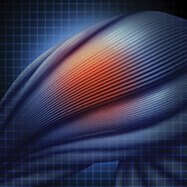Top 10 afib pearls manage cardiology's ‘bread and butter’
Atrial fibrillation has been called “the bread and butter” of cardiology, and a condition that impacts all aspects of internal medicine practice.
In his talk “Atrial Fibrillation: Risk Stratification, Anticoagulation, Future Development” at Hospital Medicine 2015, held in National Harbor, Md., this spring, Zayd A. Eldadah, MD, PhD, called afib “the bread and butter” of cardiology. “It touches hospital medicine wherever you are and impacts all aspects of internal medicine practice,” he stressed.
He offered, in reverse order, his top 10 pearls about the condition for 2015.

10. Afib is a global epidemic. The global prevalence of afib is approximately 33.5 million cases, and the global incidence is approximately 5 million new cases per year, said Dr. Eldadah, who is director of the section of cardiac electrophysiology at MedStar Washington Hospital Center and MedStar Georgetown University Hospital in Washington, D.C. Those numbers are probably underestimates, he added, and will continue to rise as the population ages. Afib affects men more than it does women and occurs in less than 1% of the population age 60 or younger, but 10% of the population age 80 or older, he noted. It's more common in patients with hypertension, heart failure, valvular heart disease, and sleep apnea.
9. Afib presents in many ways. Acute afib can be triggered by alcohol, caffeine, acute stress, pulmonary embolism, and other causes, Dr. Eldadah said, but it is eliminated by successful treatment of the underlying cause. “What we care about is nonacute afib,” he said.
Typically, he said, nonacute afib starts with a paroxysmal presentation, defined as an episode of afib that lasts 7 days or less. “It starts on its own, stops on its own, and comes and goes,” he described. If paroxysmal afib goes untreated, typically the next stage is persistent afib, which doesn't stop after 7 days and requires cardioversion or drug therapy to terminate it, he noted. Next is long-standing persistent afib, sometimes called chronic afib. “It's afib that's there all the time, Dr. Eldadah said. “It's afib that happens in patients who are left untreated—and sometimes even those who are aggressively treated. It's the presentation of afib that just continues and continues.” The last type of nonacute afib, he said, is permanent afib, which is defined by the therapeutic decision to stop attempts at afib suppression and essentially “let the afib win.”
8. Think afib, think stroke. “If there's nothing else you take out of our time together today, please make sure you take with you the critical point that having atrial fibrillation increases stroke risk,” Dr. Eldadah said. The risk is about 5 times that of nonafib patients, which Dr. Eldadah called “a very simple, very compelling, very dramatic association.” Approximately 15% of all strokes, 75,000 per year, occur in patients with afib, and due to their increased stroke risk, afib patients have double the mortality of patients with normal sinus rhythm. Strokes due to afib are also particularly severe, Dr. Eldadah noted, namely twice as deadly and twice as debilitating as non-afib strokes. “Not only do we need to worry about stroke in general, we need to worry about the severity of stroke in afib patients,” he said.
The increased risk of stroke is about the same with all categories of nonacute afib. “It's not immediately intuitive, but an individual with permanent atrial fibrillation can have the same risk of stroke as someone with episodic atrial fibrillation. The burden of afib does not define the risk of stroke; it is the other stroke risk factors that establish this risk,” he said. “The minute nonacute afib is diagnosed, that patient is immediately in a higher stroke risk category.”
Dr. Eldadah recommended using the CHA2DS2-VASc scoring algorithm, which looks at additional risk factors, to determine overall stroke risk in patients with afib. “Remember that if you want to quantify stroke risk in a person with nonacute afib, it doesn't matter if they have paroxysmal afib or permanent afib. What matters are the other risk factors,” he said.
7. Control thrombosis risk. Management of afib in 2015 should focus on thrombosis control, rate control, and rhythm control, according to the 2014 American Heart Association/American College of Cardiology Guidelines for the Management of Patients with Atrial Fibrillation. Dr. Eldadah summarized recommendations for thrombosis control. For patients with a mechanical heart valve, he said, warfarin is the only anticoagulation option. People who are high risk, with a CHA2DS2-VASc score of 2 or greater, should be on anticoagulants, either warfarin or one of the novel oral anticoagulants. People who are at moderate risk, with a CHA2DS2-VASc score of 1, should be taking an oral anticoagulant, aspirin, or no therapy, while in those at low risk, with a CHA2DS2-VASc score of 0, it is reasonable to use no antithrombotic therapy.
Dr. Eldadah reminded his audience that while maintaining therapeutic anticoagulation with warfarin can be difficult, it's important to manage it well, since stroke risk doubles in patients who spend less than two-thirds of their time with an international normalized ratio (INR) in the therapeutic range of 2.0 to 3.0. “It's a real challenge with real health consequences if you don't maintain people within that therapeutic range. And it's not easy to do,” he said.
The newer alternatives to warfarin—dabigatran, rivaroxaban, apixaban, and edoxaban—all have rapid onset and offset of action and none require INR monitoring, Dr. Eldadah said. Dabigatran and apixaban have shown superior stroke protection versus warfarin, and rivaroxaban and edoxaban have been shown to be noninferior to warfarin. Apixaban also showed a reduction in mortality driven by lower intracranial hemorrhage. Pooled meta-analysis of data on the novel anticoagulants from the RE-LY, ROCKET-AF, ARISTOTLE, and ENGAGE AF TIMI-48 trials found that they reduced relative risk of stroke or systemic embolism, hemorrhagic stroke, all-cause mortality, and intracranial hemorrhage versus warfarin with a “small, barely statistically significant” increase in relative risk for GI bleeding, Dr. Eldadah said. He noted that these data “argue very favorably for a novel anticoagulant over a drug that's 60 years old and challenging [to manage].”
6. Control heart rate. Afib can cause rapid heart rates, which in turn can cause or exacerbate heart failure, precipitate myocardial infarction, and worsen afib symptoms. Physicians can intervene by prescribing such medications as beta-blockers, calcium-channel blockers, digoxin, and antiarrhythmic drugs. Atrioventricular junction ablation and permanent pacing can be used for refractory rapid rates and in elderly or complicated patients, Dr. Eldadah said.
5. Restore sinus rhythm with a drug. Besides managing stroke risk and controlling heart rate, one of the main concerns in dealing with afib is addressing the symptoms of the disease, Dr. Eldadah said.
“I often talk to patients and tell them that ‘When you have afib, it's kind of like your heart's a 6-cylinder car engine that's lost 3 of its cylinders. Three of the cylinders are knocking and the other 3 are working. So sure, you can get around, you can drive around town, but it's not going to be a very happy ride,’” he said.
Patients who are not in sinus rhythm report decreased quality of life because of such symptoms as palpitations, fatigue, chest pain, anxiety, and depression, he noted. Those who have heart failure and atrial fibrillation together can be affected by what Dr. Eldadah called “the cycle of doom,” since the 2 conditions feed on and worsen one another. “When you see atrial fibrillation, especially in a heart failure patient, that should really trigger a heightened alert to try to do something to suppress the afib and maintain rhythm,” he said.
First-line therapy involves antiarrhythmic drugs, including sodium-channel blockers, beta-blockers, potassium-channel blockers, and calcium-channel blockers. Amiodarone is the preferred drug in most cases but with a few important caveats: It has the worst side effect profile and was never FDA-approved to treat afib, Dr. Eldadah noted, meaning that its use is off label and necessitates a thorough conversation about potential risks with patients. “It's still the best drug we have available, but it's the best drug in a category of mediocre drugs. It's just less mediocre than everything else,” he said.
4. When drugs fail, ablate afib. Current therapy involves tailored ablation based on the kind of afib a patient has, such as paroxysmal or longstanding persistent, Dr. Eldadah said. “The bottom line is that [with ablation] we modify the atrial substrate invasively for people who need more than just drug therapy,” he described. Two meta-analyses of 63 afib studies found a 57% rate of single-procedure success of ablation with no antiarrhythmic drug therapy, a 71% multiple-procedure success rate without drug therapy, a 77% multiple-procedure success rate with drug therapy, and a 52% success rate for drug therapy alone. Dr. Eldadah said more data are needed on direct comparison of ablation techniques, for example, cryoballoon versus radiofrequency ablation, and on catheter ablation versus antiarrhythmic drug therapy. The ongoing CABANA trial is looking at the latter question, he noted.
3. When catheters fail, cut. “Sending the patient to the surgeon is based on the fact that sometimes the lesions that you can create with a catheter aren't as good as the lesions a surgeon can create all the way through the myocardium,” Dr. Eldadah said. For convergent atrial fibrillation, traditional catheter ablation is augmented with surgical epicardial ablation to better isolate the pulmonary veins and posterior left atrium. It is particularly useful in long-standing afib patients, Dr. Eldadah said. Other methods of ablation include minimally invasive surgical ablation and MAZE surgery. The latter is done in patients already undergoing open-heart procedures.
Afib surgery can be considered in symptomatic afib patients undergoing other cardiac surgical procedures and selected asymptomatic afib patients undergoing cardiac surgery in whom ablation can be performed with minimal risk. Stand-alone afib surgery can also be considered in symptomatic afib patients who prefer a surgical approach, who are not candidates for catheter ablation, or in whom at least one attempt at catheter ablation has failed, Dr. Eldadah said.
2. Always consider risks. “We're all in the business of medicine,” Dr. Eldadah said. “A lot of the things we do are risky when you invade people's vasculature and hearts.” Worldwide registry data on ablation for afib indicate a major complication rate of 4.5%, a mortality rate of 0.15%, and a pulmonary vein stenosis rate of 1.3%. Other complications include atrial-esophageal fistula, phrenic nerve injury, and thromboembolism. In addition, Dr. Eldadah noted, even with successful ablation, continued anticoagulation may still be necessary, since increased thromboembolism risk may be independent of clinical atrial fibrillation, silent afib may persist despite relief of symptoms, and anticoagulation is based on thrombosis risk. CABANA may guide future management, he noted.
1. Individualize therapy. Dr. Eldadah's final pearl and take-home message was very simple. “When you see someone with afib, treat that individual as an individual; don't use a one-size-fits-all approach. Not everybody needs to be anticoagulated with a novel agent, not everybody needs warfarin, not everybody needs ablation,” he said. “Think about the individual patient; have the conversation.”




